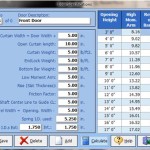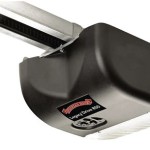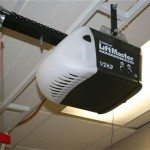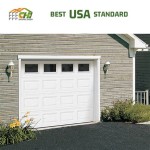Understanding 10 Foot Wide Garage Doors: Benefits, Considerations, and Applications
Garage doors are an integral part of residential and commercial properties, providing security, weather protection, and aesthetic appeal. The standard garage door width often ranges from 8 to 9 feet for single-car garages and 16 feet for double-car garages. However, specific needs and architectural designs may necessitate alternative sizes. A 10-foot wide garage door presents a unique and often advantageous option, balancing space efficiency and accessibility.
This article will explore the various facets of 10-foot wide garage doors, examining their benefits, the factors influencing their selection, different types available, installation considerations, maintenance requirements, and relevant safety protocols. The intent is to furnish readers with a comprehensive understanding of this increasingly popular garage door size, enabling informed decisions when considering or implementing such systems.
The Advantages of Opting for a 10 Foot Wide Garage Door
Choosing a 10-foot wide garage door over standard sizes offers several distinct advantages, primarily centered around improved space utilization and enhanced maneuverability. These benefits are particularly relevant for properties with specific spatial constraints or unique vehicle storage needs.
Firstly, a 10-foot wide door provides increased clearance compared to an 8 or 9-foot wide door. This extra width simplifies the process of driving vehicles in and out of the garage, reducing the risk of accidental bumps or scratches, especially for larger vehicles like trucks or SUVs. The added space is also beneficial for individuals with mobility issues or those who require extra room to navigate around the vehicle.
Secondly, a 10-foot wide door can facilitate better storage within the garage. The extra width allows for more efficient organization of tools, equipment, or other items alongside the parked vehicle. This is particularly useful for homeowners who utilize their garage as a workshop or storage space, as it minimizes the need to constantly move items to accommodate the vehicle.
Thirdly, a 10-foot door can enhance the aesthetic appeal of a property. When integrated thoughtfully into the architectural design, a slightly wider door can create a more balanced and visually appealing facade. This can be particularly effective for modern or contemporary style homes where clean lines and symmetry are emphasized.
Finally, in commercial settings, a 10-foot wide door can improve operational efficiency. It allows for easier access for delivery vehicles, equipment, or other materials, streamlining workflows and minimizing potential bottlenecks. This is particularly relevant for businesses that require regular access to their garage or storage areas.
However, the benefits need to be weighed against the potential drawbacks, such as a slightly higher initial cost and the potential need for structural modifications to accommodate the larger opening.
Key Considerations When Selecting a 10 Foot Wide Garage Door
Several factors must be carefully considered before selecting a 10-foot wide garage door. These factors encompass the physical dimensions of the garage, the intended use of the space, and specific aesthetic preferences. Addressing these considerations ensures the selected door is both functional and visually appropriate for the property.
Firstly, the existing dimensions of the garage opening must be accurately measured. While a 10-foot door implies a 10-foot wide opening, the actual rough opening might require slight adjustments to ensure a proper fit. Structural modifications, such as widening the opening or reinforcing the surrounding frame, may be necessary. Consulting with a qualified contractor is crucial to assess the feasibility and cost implications of such modifications.
Secondly, the type of vehicle or equipment that will be stored in the garage should be considered. If the primary purpose of the garage is to store a large truck, SUV, or recreational vehicle, a 10-foot wide door may be essential. However, if the garage is primarily used to park a smaller car, the added width may not be necessary and a standard size door may suffice. The potential for future vehicle upgrades should also be factored into the decision.
Thirdly, the desired aesthetic of the garage door should align with the overall architectural style of the property. 10-foot wide doors are available in a variety of materials, designs, and finishes. Selecting a door that complements the existing architecture can significantly enhance the curb appeal of the property. Options range from traditional raised-panel designs to modern flush panels in materials such as wood, steel, aluminum, and composite.
Fourthly, the level of insulation required should be considered. Garage doors can contribute significantly to the overall energy efficiency of a home. Insulated doors help to regulate temperature within the garage, reducing energy costs and improving comfort. The R-value of the insulation should be selected based on the climate and the intended use of the garage.
Finally, the choice of garage door opener system should be appropriate for the size and weight of the door. A 10-foot wide door will typically be heavier than a standard size door, requiring a more powerful opener. Belt-drive openers are generally quieter than chain-drive openers, while direct-drive openers offer the highest level of reliability and quiet operation. Safety features, such as automatic reversal systems and photoelectric sensors, are essential for preventing accidents.
Exploring Different Types of 10 Foot Wide Garage Doors
The availability of 10-foot wide garage doors extends across various types, each offering distinct operational characteristics, aesthetic styles, and material compositions. Understanding these differences is vital for making an informed selection that matches specific needs and preferences.
Sectional garage doors are arguably the most popular type. They consist of hinged panels that rise vertically along tracks located on either side of the opening. When open, the panels are stored horizontally under the garage ceiling. Sectional doors are available in a wide range of materials, including steel, aluminum, wood, and composite. They offer excellent insulation and security features are often customizable to match the architectural style of the property.
Roll-up garage doors, also known as coiling doors, consist of a single sheet of material that rolls up into a coil above the opening. These doors are commonly used in commercial settings where space is limited. They are typically made of steel or aluminum and are highly durable and secure. Roll-up doors are a practical choice for garages with low headroom, as they do not require overhead tracks.
Carriage house garage doors are designed to mimic the appearance of traditional swinging doors. They can be either sectional or swing-out, and are often made of wood or composite materials. Carriage house doors add a touch of elegance and sophistication to a property, but they may require more space to operate than other types of garage doors. They are commonly found on older homes or in neighborhoods with a more traditional aesthetic.
Tilt-up garage doors, also known as one-piece doors, consist of a single panel that tilts up and back into the garage. These doors were once a popular option, but they are now less common due to safety concerns and space limitations. Tilt-up doors require a significant amount of headroom and can be difficult to operate in windy conditions. They are typically made of wood or steel and are available in a limited range of styles.
Finally, custom-designed garage doors offer the greatest flexibility in terms of size, materials, and style. These doors are typically built to order and can be tailored to meet specific architectural requirements. Custom doors can be made from a variety of materials, including exotic woods, glass, and metal. They offer a unique and personalized touch to a property, but they are also the most expensive option.
The choice of garage door type will depend on factors such as budget, space constraints, aesthetic preferences, and the level of security and insulation required.
The decision to install a 10-foot wide garage door is a multifaceted process requiring careful consideration of various factors. By understanding the advantages, key considerations, and different types available, property owners can make an informed decision that effectively balances functionality, aesthetics, and budget.

Redirecting

Wooden Garage Doors 7 Ft High X 10 Wide Capital Extra Range

Large High Opening Residential Garage Door Project Gr8

16 Ft Wide By 10 Tall Full View Garage Door Matt Black Finish With

10 Feet 2 Inches Wide Olive Green Gliderol Roller Garage Door Doors Operators And Accessories From Countrywide Top Quality At The Lowest Prices

Rolin Up 10x10 Foot Garage Door

10 Ft Wide By Tall Full View Garage Door Matt Black Finish With Clear Glass

Fiberglass Swing Out Garage Doors Non Warping Patented Wooden Pivot Door Sliding And Eco Friendly Metal Cores

What Are The Standard Garage Door Sizes Clopay

Wayne Dalton Classic Steel Model 9100 10 Ft X 7 9 R Value Insulated White Single Garage Door In The Doors Department At Lowes Com








